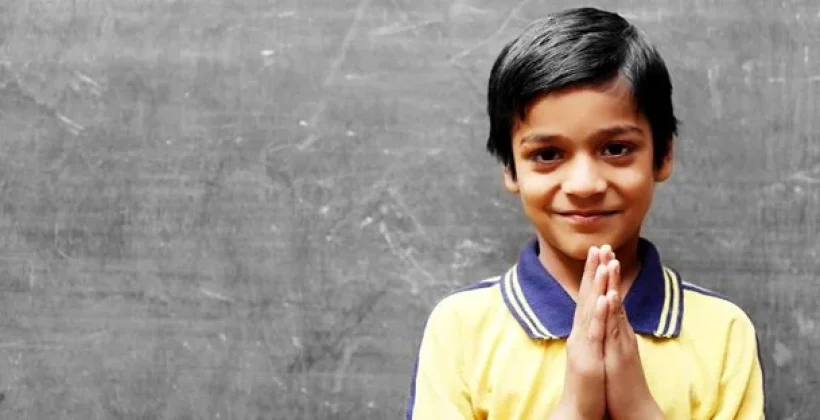Meaning and Significance of Namaste or Namaskar
Namaskar or Namaste is a symbol of showing respect of expressing devotion to God in Indian culture. This greeting highlights humility, promotes positivity, and acknowledges the divine with others. It symbolizes in-depth cultural and spiritual values, which brings mutual respect.

The most traditional and humble way of greeting others is Namaste. Through this, people also express their devotion during worship. People commonly show their gesture by joining hands and press palms together near the chest.
Commonly practiced in India, Namaste has become highly popular across the world. Even foreigners also use it as a humble greeting. In Hollywood too, it has made its mark where the characters show their politeness or make a request by folding their hands.
Most people don’t know about the meaning of Namaskar. Beyond its meaning as a greeting, Namaste is also a tradition that is vastly used to show respect and devotion.
What is the Meaning of Word, Namaste?
Namaste is not only used to give respect or express devotion. This is a combination of two words, Namah’ and ‘Te’, derived from the Sanskrit language. This word means “I Salute” or “I Pay Obeisance”. Namah’s equivalent words in English are ‘bow’, ‘adoration’, ‘devotion’. ‘Te’ means ‘to you’. So, the combined word Namaste means ‘I bow to you in reverence’.
What are the advantages of Doing Namaskar?
By doing Namaskar to an elder, a spiritually acclaimed person (such as a Saint or Guru), or to a Deity, one get blessings through this act of salutation.
That way, the person doing the Namaskar becomes the recipient of sattvic (pure) components through subtle frequencies of bliss and higher level of spirituality emitted by them.
This leads to increase in positivity in us through Sattvic Gunas, such as better humility, reduction/mitigation of ego and an attitude of gratitude.
Our physical and subtle bodies absorb good virtues, and their importance is impressive upon our thinking. Slowly but steadily, we start changing & becoming better people. This makes our character stronger as we start following the path of good and truth.
Prediction based on your Moon sign are most accurate as per Vedic Astrology. Do you know your Moon Sign? If not, find out instantly for Free by filling out the form below!
Why is Namaskar preferred over handshake?
In case the person is negative (due to depression, guilt, hate, anxiety, jealousy), the touch through handshake can transfer these undesirable emotions – which are categorized under the following Guna (quality): Rajas (uncontrolled passion) and Tamas (vices that lead to darkness in life).
Spiritual depth of Namaskar
The reason why we do Namaskar has a deep spiritual significance also. It recognizes the belief that the life force, the divinity, the Self or the God in me is the same in all. Acknowledging this oneness with the meeting of the palms, we honor the God in the person we meet.
There is reverence conveyed by one person to the other by doing Namaskar. The literal meaning implied is ‘I recognize the God in you, and I bow to you’. Another equivalent of this expression could be ‘prostration and solutions’.
Our ancient culture and religion emphasize that God is omnipresent. God is not away from us residing somewhere high in the sky or in the heaven. Thus, the concept of Namaskar teaches us to remember that God is everywhere and in everything. It is believed that there is atman (soul) in all, and atman is a part of the Supreme. Therefore, we are all one. Hence, the divine message is to love everyone because no one is different from the other.
Namaskar is also directly related to the heart chakra or the ‘Anhat chakra’. It helps in reconnecting with our deep selves and to the other person through our hearts. During prayer and meditation, it helps in calming or activating the heart chakra. When placed on the forehead, it helps in activating our third eye or the ‘Ajna chakra’ or calming it and reconnecting to our soul and our intuition.
Namaste in Prayers
When worshipping or praying, Hindus not only fold their hands but also bow and close their eyes, to connect with higher powers. This physical and mental gesture combined is sometimes accompanied by changing the name of God or reciting a “Stotra”, “Chalisa” or a “Mantra“.
Can Namaskar be casual too?
Namaste could be just a casual as well as a formal greeting to an elderly person or wishing a person of same age or an act of worship. However, there is much more to it than meets the eye. The real meeting between people is the meeting of their minds.
When we greet one another with Namaste, it means, ‘may our minds meet’, indicated by the folded palms placed before the chest. The bowing down of the head is a gracious form of extending friendship in love, respect and humility.
Forms of Namaste
- Namaskar to a Person of the Same Age Group
Join your hands together and place the thumbs at the center of the chest. This form or mudra makes the fingers the antenna for receiving Sattvic frequencies of the universe. The closeness to the chest is to activate the anhat chakra. This increases the humility in the person, at the same time creating a circle of bliss around the person.
- Namaskar to an Elder
Same as (a), but the hands are raised together and in front of the forehead (the site of third eye) and the head is slightly lowered to convey deep respect.
- Namaskar while Praying
Join the fingers and thumbs of both the hands but the fingers should be loose (and not rigid or straight). The thumbs should not join the fingers. The inner portion of the palms should have some space between them. The eyes are closed, the head is bowed, and the hands could go completely above the head. This is the highest form of reverence.
Another signification of Namaste
Bringing hands together is a highly symbolic gesture. According to tradition, the right hand represents the higher self or the divine within, while the left hand represents the lower, worldly self. By pressing the palms together, the person doing Namaskar unites these two aspects and at the same time tries to connect with the individual before him or her. Universally, bowing expresses love and respect.
Conclusion
Namaste is not just a social habit or a cultural aspect. There is a deep science behind it. If one is doing sadhana, every time one joins palms together, there is a crackle of energy – a boom is experienced.
With a better understanding of the word and the concept of Namaskar, it is hoped that this beautiful way of greeting and wishing will bring in more love, respect and humility in our society.

Detailed Horoscope Reading
An indepth study of your birth chart will predict your future in great detail. This will not just give you peace of mind by removing the elements of uncertainty from your future, but will also help you prepare ahead of the low periods and leverage the good phases in the coming years ... Read More










